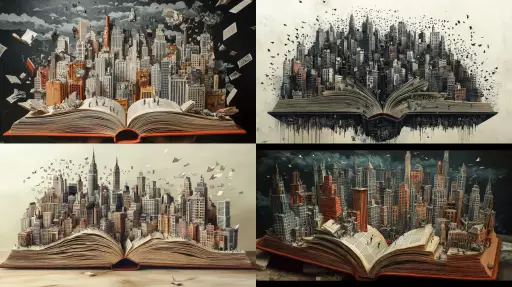Explore the Best AI Image Gallery

The Algorithmic Brush: Navigating the Ethics of AI-Generated Media
The realm of media creation is undergoing a profound transformation, fueled by the rapid advancements in artificial intelligence (AI).
AI algorithms are now capable of generating astonishingly realistic images, videos, music, and even text, blurring the lines between human and machine creativity. This burgeoning field of AI-generated media presents both exhilarating opportunities and complex ethical challenges that demand careful consideration.
A New Canvas for Creativity: Exploring the Potential
AI-powered tools offer a myriad of exciting possibilities for creators across various disciplines:
- Art and Design: AI algorithms can assist artists in conceptualizing new ideas, generating unique compositions, and experimenting with different styles. Imagine an artist collaborating with an AI to explore surreal landscapes or abstract forms.
- Music Production: AI can compose original music pieces in diverse genres, helping musicians overcome creative blocks or explore innovative soundscapes. Imagine a composer using AI to create a soundtrack for a film, blending orchestral arrangements with electronic elements.
- Video Game Development: AI can generate realistic environments, characters, and even storylines, streamlining the game development process and enabling developers to focus on core gameplay mechanics.
- Marketing and Advertising: AI can personalize marketing campaigns by generating tailored content, creating engaging visuals, and optimizing ad copy for specific audiences.
Ethical Crossroads: Navigating the Complexities
While the potential of AI-generated media is undeniable, it also raises a number of ethical concerns:
- Copyright and Ownership: Who owns the copyright to AI-generated content? Is it the creator who inputs the prompts, the AI developer, or the AI itself?
- Bias and Fairness: AI algorithms are trained on massive datasets, which can reflect existing societal biases. This can result in AI-generated content perpetuating stereotypes or discrimination.
- Authenticity and Deception: The ability to create highly realistic AI-generated media raises concerns about the spread of misinformation and deepfakes – videos or audio recordings that convincingly portray someone saying or doing something they never did.
- Job Displacement: As AI becomes more capable, there are concerns that it could automate creative tasks, potentially leading to job losses in certain industries.
Shaping the Future: Responsible Innovation and Collaboration
Addressing these ethical challenges requires a multi-faceted approach involving:
- Transparent Development Practices:** AI developers should be transparent about their algorithms, training data, and potential biases.
- Ethical Guidelines and Regulations:** Governments and industry bodies need to establish clear guidelines and regulations for the development and use of AI-generated media.
- Education and Awareness:** Raising public awareness about the capabilities and limitations of AI is crucial for informed decision-making.
- Collaborative Efforts:** Fostering collaboration between artists, technologists, ethicists, and policymakers will be essential for navigating the complex ethical landscape of AI-generated media.
The intersection of AI and creativity presents both immense opportunities and profound challenges. By embracing a responsible and ethical approach, we can harness the power of AI to augment human creativity, foster innovation, and shape a future where technology empowers artistic expression.





](https://images.ai-img.art/thumbnails/150/157712d76865d557120f9baf988de3d0525225295a2789c89bf2c4a5a96a03d1.webp)
![**Representation: A dog acting as a private tutor to a child. The dog holds a ruler in its paw and stands at the blackboard to explain a dog diagram to the child. Graphic style: Line drawing, cartoon style, influenced by Franco-Belgian comics, thick black lines, simplified design, vector, black and white only, in the style of Keith Haring or the French comic strip "Alinéa". [IMPORTANT]: A single continuous line extending from one side of the image to the other, minimalist, strong outlines, line drawing, without lifting the hand, ultra-simplified, no shading, entirely white image, drawing created in the center of a sheet of paper. --ar 16:5** - <@627984126871470085> (fast)](https://images.ai-img.art/thumbnails/150/7a854648a81e51241dcca8d24dd6e3bfcf07ad1df51baf401c9b729f4cf411fa.webp)

![**Representation: A dog acting as a private tutor to a child. The dog holds a ruler in its paw and stands at the blackboard to explain a dog diagram to the child. Graphic style: Line drawing, cartoon style, influenced by Franco-Belgian comics, thick black lines, simplified design, vector, black and white only, in the style of Keith Haring or the French comic strip "Alinéa". [IMPORTANT]: A single continuous line extending from one side of the image to the other, minimalist, strong outlines, line drawing, without lifting the hand, ultra-simplified, no shading, entirely white image, drawing created in the center of a sheet of paper. --ar 16:5** - Variations (Strong) by <@627984126871470085> (fast)](https://images.ai-img.art/thumbnails/150/f4e034998ccd869d8a061fd12017514fcd92210eb33d4222dc9b54716223f4dd.webp)





![**Representation: A teenager smiling while thinking about a friendly dog, a comic-style thought bubble with a friendly dog inside. Graphic style: Line drawing, cartoon style, influenced by Franco-Belgian comics, thick black lines, simplified design, vector, black and white only, in the style of Keith Haring or the French comic strip "Alinéa". [IMPORTANT]: A single continuous line extending from one side of the image to the other, minimalist, strong outlines, line drawing, without lifting the hand, ultra-simplified, no shading, entirely white image, drawing created in the center of a sheet of paper. --ar 16:5** - <@627984126871470085> (fast)](https://images.ai-img.art/thumbnails/150/6fc850f638e3dee0c4b121acecad2c8419e02bdeac7f871d625f1003c1c3abe1.webp)



](https://images.ai-img.art/thumbnails/150/9d51c5e673b4f2068b7b01abc35425a06f173b76303adf9ad29ca14302c25b18.webp)










](https://images.ai-img.art/thumbnails/150/51c93500396faff4e7fa8b42bc68033067b16b2230e3496e95c482a581ff0fe9.webp)














